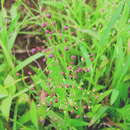Comments
provided by eFloras
This is a very common aquatic grass growing on the plains, in rice fields and in shallow water, and is acceptable to grazing animals, and since it is common it is of considerable importance. Sometimes it is a troublesome weed in rice fields.
- license
- cc-by-nc-sa-3.0
- copyright
- Missouri Botanical Garden, 4344 Shaw Boulevard, St. Louis, MO, 63110 USA
Comments
provided by eFloras
This is a widespread and very variable species. It includes several ill-defined entities that have been given specific rank in the past. The typical form, from Japan, has spikelets with the florets only slightly dissimilar, nearly equal in length and texture and the upper floret rounded on the back without a central groove. This form is the most common entity in China. Specimens from India usually have more clearly unequal florets, the lower one longer and thinner, with a deep, longitudinal groove on the back. This form may have a glabrous or pubescent upper floret, and the pubescent variant is the basis of the name
Isachne mili-acea. In SE Asia this division breaks down, with many intermediate forms. Specimens in which the florets are nearly equal but the lower one is grooved also occur in China. There is much variation in habit and spikelet size unrelated to other characters.
This species is a forage grass, but also a troublesome weed of rice fields.
- license
- cc-by-nc-sa-3.0
- copyright
- Missouri Botanical Garden, 4344 Shaw Boulevard, St. Louis, MO, 63110 USA
Description
provided by eFloras
Milium globosum Thunb., Fl. Jap. 49. 1784.
Isachne australis R. Br., Prodr. 196. 1810; Hook. f., Fl. Brit. Ind. 7: 24. 1879; Hayata Icon. Pl. Form. 7: 57.
1918.
Culm tufted, branching and rooting at the lower nodes, the flowering culm 30-60 cm long. Blade linear-lanceolate, 2-8 cm long; sheath shorter than the internode, ciliate on the margins; ligule a ring of hairs. Panicle open, with yellowish glandular bands on the panicle branchlets. Spikelets sometimes purplish, about 2 mm long, glumes broadly elliptical, slightly shorter than the spikelet, nerves obscure, glabrous or hispidulous toward the obtuse apex; lower floret staminate, slightly larger and of a thinner texture than the glabrous or pubescent upper floret; anther about 0.9 mm long.
- license
- cc-by-nc-sa-3.0
- copyright
- Missouri Botanical Garden, 4344 Shaw Boulevard, St. Louis, MO, 63110 USA
Description
provided by eFloras
Perennial. Culms slender to moderately robust, erect or decumbent and rooting at lower nodes, up to 80 cm tall, nodes glabrous, eglandular or with glandular ring. Leaf sheaths shorter than internodes, glabrous except for ciliate outer margin; leaf blades narrowly lanceolate, 3–10 × 0.4–0.8 cm, glabrous, scabrid, base rounded, apex acute; ligule 1–2 mm. Panicle open, ovate in outline, 4–11 cm, glandular, many-spiculate; branches and pedicels filiform, flexuose; pedicels variable in length, shorter or longer than spikelets. Spikelets elliptic-globose, 1.5–2(–2.2) mm, greenish or purplish brown; florets slightly to clearly dissimilar; lower floret male, upper floret female; glumes subequal, as long as or shorter than florets, broadly elliptic, 5–7(–9)-veined, usually glabrous, rarely hispidulous or scaberulous above middle, apex broadly rounded; lower lemma oblong, cartilaginous to subcrustaceous, shallowly convex, back sometimes sulcate, smooth, glabrous; anthers 0.8–1.3 mm; upper lemma crustaceous, shorter and more convex, slightly rough, back glabrous or puberulous, upper margins ciliate. Fl. and fr. summer to autumn. 2n = 60.
- license
- cc-by-nc-sa-3.0
- copyright
- Missouri Botanical Garden, 4344 Shaw Boulevard, St. Louis, MO, 63110 USA
Distribution
provided by eFloras
Nepal, S.E. Asia, Japan, Australia.
- license
- cc-by-nc-sa-3.0
- copyright
- Missouri Botanical Garden, 4344 Shaw Boulevard, St. Louis, MO, 63110 USA
Habitat & Distribution
provided by eFloras
Wet places, forming colonies, and as a weed of rice fields. Anhui, Fujian, Guangdong, Guangxi, Guizhou, Hebei, Henan, Hubei, Hunan, Jiangsu, Jiangxi, Liaoning, Shaanxi, Shandong, Taiwan, Yunnan, Zhejiang [Bangladesh, Bhutan, India, Indonesia, Japan, Korea, Malaysia, Nepal, New Guinea, Philippines, Sri Lanka, Thailand, Vietnam; Australia, Pacific Islands].
- license
- cc-by-nc-sa-3.0
- copyright
- Missouri Botanical Garden, 4344 Shaw Boulevard, St. Louis, MO, 63110 USA
Physical Description
provided by USDA PLANTS text
P erennials, Terrestrial, not aquatic, Stems nodes swollen or brittle, Stems erect or ascending, Stems geniculate, decumbent, or lax, sometimes rooting at nodes, Stems terete, round in cross section, or polygonal, Stems branching above base or distally at nodes, Stem nodes bearded or hairy, Stem internodes hollow, Stems with inflorescence less than 1 m tall, Stems, culms, or scapes exceeding basal leaves, Leaves mostly cauline, Leaves conspicuously 2-ranked, distichous, Leaves sheathing at base, Leaf sheath mostly open, or loose, Leaf sheath smooth, glabrous, Leaf sheath and blade differentiated, Leaf blades disarticulating from sheath, deciduous at ligule, Leaf blades lanceolate, Leaf blade auriculate, Leaf blades 2-10 mm wide, Leaf blades 1-2 cm wide, Leaf blades mostly flat, Leaf blades mostly glabrous, Leaf blades scabrous, roughened, or wrinkled, Ligule present, Ligule a fringed, ciliate, or lobed membrane, Ligule a fringe of hairs, Inflorescence terminal, Inflorescence an open panicle, openly paniculate, branches spreading, Inflorescence solitary, with 1 spike, fascicle, glomerule, head, or cluster per stem or culm, Inflorescence branches more than 10 to numerous, Flowers bisexual, Flowers unisexual, Spikelets pedicellate, Spikelets sessile or subsessile, Spikelets dorsally compressed or terete, Spikelet less than 3 mm wide, Spikelets with 2 florets, Spikelets solitary at rachis nodes, Spikelets bisexual, Spikelets disarticulating above the glumes, glumes persistent, Rachilla or pedicel glabrous, Glumes present, empty bracts, Glumes 2 clearly present, Glumes equal or subequal, Glumes equal to or longer than adjacent lemma, Glumes 3 nerved, Glumes 4-7 nerved, Glumes 8-15 nerved, Lemmas thin, chartaceous, hyaline, cartilaginous, or membranous, Lemma similar in texture to glumes, Lemma 5-7 nerved, Lemma body or surface hairy, Lemma apex truncate, rounded, or obtuse, Lemma awnless, Lemma margins thin, lying flat, Lemma straight, Palea present, well developed, Palea membranous, hyaline, Palea longer than lemma, Stamens 3, Styles 2-fid, deeply 2-branched, Stigmas 2, Fruit - caryopsis.

